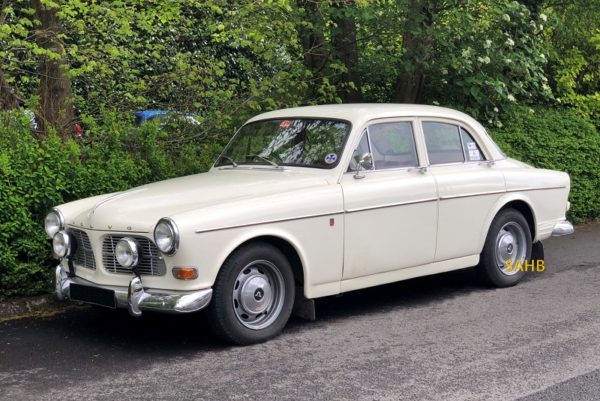
The Volvo 120 Amazon may appear to represent the epitome of the conventional mid-sized family car – but this example follows the honourable tradition of Volvo rally cars: not only sporting a fine pair of spotlights but with four-point rally harnesses inside and numerous rally stickers on the windows. Its owner is clearly an enthusiastic competitor in historic rallying.
This model was built between 1956 and 1967. It shared the wheelbase and seating position of its predecessor the PV444/544 and was offered as a two- and four-door saloon and five-door estate car. In 1959 Volvo were the world’s first manufacturer to provide front seat belts as standard equipment, and provided them on all Amazon models. Later, the Amazon was the first to have three-point seat belts as standard equipment. Other safety features on the Amazon were a padded upper half of the dashboard and a laminated windscreen.
The model’s name at launch was Amason (with an ‘s’), alluding to the female warriors of Greek mythology. However, German motorcycle manufacturer Kreidler had already registered the name (albeit spelt Amazone). They agreed that Volvo could use the name, but only within Sweden, and with the spelling Amazon.
The Amazon was first manufactured at Volvo’s Lundby plant in Gothenburg; in 1964 production moved to the new Torslandaverken plant. A total of 234,653 four-door models, 359,917 two-door models and 73,220 estate cars were produced, of which 60% were exported.
The car’s ponton styling was influenced by US design, closely resembling the Chrysler New Yorker sedan and the Chrysler 300C hardtop coupe. The designer was Jan Wilsgaard, who claimed to have been inspired by a Kaiser that he saw at Gothenburg harbour.
The model was designated initially as the 120 series. The 121 was the base model with a single carburettor and 66 bhp, and the 122S introduced in 1958 was the performance model with twin carburettors and 85 bhp.
In the autumn of 1961, the 120 models received some relatively large changes. The 1.6-litre B16 engine was replaced by the B18 with an output of 75 or 90 bhp, a 12-volt electrical system and a new grille, while the 90 bhp model featured disc brakes on the front wheels.
The 4-door model of the 120 was produced until the autumn of 1966, when it was replaced by an entirely new car, the Volvo 144.







Leave a Comment